 W
WAd Lib, Inc. was a Canadian manufacturer of sound cards and other computer equipment founded by Martin Prevel, a former professor of music and vice-dean of the music department at the Université Laval. The company's best known product, the AdLib Music Synthesizer Card (ALMSC), or simply the AdLib as it was called, was the first add-on sound card for IBM compatibles to achieve widespread acceptance, becoming the first de facto standard for audio reproduction.
 W
WApogee Electronics is an American manufacturer of digital audio interfaces and audio converters, USB & iOS microphones as well as audio production software.
 W
WAureal Semiconductor Inc. was an American electronics manufacturer, best known throughout the mid-late 1990s for their PC sound card technologies including A3D and the Vortex The company was the reincarnation of the, at the time, bankrupt Media Vision Technology, who developed and manufactured multimedia peripherals such as the Pro Audio Spectrum 16.
 W
WC-Media Electronics, Inc. is a Taiwan computer hardware company that manufactures processors for PC audio and USB storage, and wireless audio devices.
 W
WThe Covox Speech Thing is an external audio device attached to the computer to output digital sound. It was composed of a primitive 8-bit DAC using a resistor ladder and an analogue signal output, and plugged into the printer port of the PC.
 W
WThe Wave Blaster was an add-on MIDI-synthesizer for Creative Sound Blaster 16 and Sound Blaster AWE32 family of PC soundcards. It was a sample-based synthesis General MIDI compliant synthesizer. For General MIDI scores, the Wave Blaster's wavetable-engine produced more realistic instrumental music than the SB16's onboard Yamaha-OPL3.
 W
WE-MU Systems was a software synthesizer, audio interface, MIDI interface, and MIDI keyboard manufacturer. Founded in 1971 as a synthesizer maker, E-mu was a pioneer in samplers, sample-based drum machines and low-cost digital sampling music workstations.
 W
WThe Ensoniq AudioPCI is a PCI-based sound card released in 1997. It was Ensoniq's last sound card product before they were acquired by Creative Technology. The card represented a shift in Ensoniq's market positioning. Whereas the Soundscape line had been made up primarily of low-volume high-end products full of features, the AudioPCI was designed to be a very simple, low-cost product to appeal to system OEMs and thus hopefully sell in mass quantities.
 W
WThe Ensoniq ES-5506 "OTTO" is a chip used in implementations of sample-based synthesis. Musical instruments and IBM PC compatible sound cards were the most popular applications.
 W
WThe Ensoniq ESP was used in many of the company's musical instruments and on their Soundscape Elite PC ISA sound card. It was used to enhance the synthesizer's audio samples with digital effects, enhancing the realism of the overall sound.
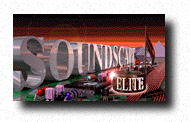 W
WThe Soundscape ELITE was Ensoniq's high-end ISA PC sound card offering. It offers the highest MIDI quality of any PC sound card Ensoniq produced. The board is an evolution of the company's previous Soundscape S-2000. The Soundscape ELITE was launched in March 1995.
 W
WThe Ensoniq Soundscape OPUS (SS-3016-NCD) is a Gateway 2000 OEM sound card, and possibly was used by other OEMs, but was never sold to Ensoniq's customers directly. It was a Soundscape-like board, using the Ensoniq "OPUS" multimedia sound chip that only was used on these OEM boards. It had a 1MB patch set ROM chip, resulting in a lesser MIDI quality compared to the Soundscape and Soundscape ELITE. The "OPUS" cards again carry the Motorola 68EC000 CPU. The variety of CD-ROM interfaces have been removed. Otherwise, however, the card is simply a cost-reduced Soundscape-compatible board with similar capabilities.
 W
WSoundscape S-2000 was Ensoniq's first direct foray into the PC sound card market. The card arrived on the market in 1994. It is a full-length ISA digital audio and sample-based synthesis device, equipped with a 2 MiB Ensoniq-built ROM-based patch set. Some OEM versions of the card feature a smaller 1 MiB patch set. It was praised for its then-high quality music synthesis and sound output, high compatibility and good software support.
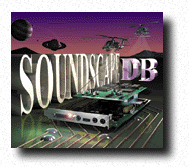 W
WThe SoundscapeDB is an Ensoniq-designed and produced MIDI daughtercard designed to interface with the "Waveblaster" pin header available on many older sound cards. It was released in 1994.
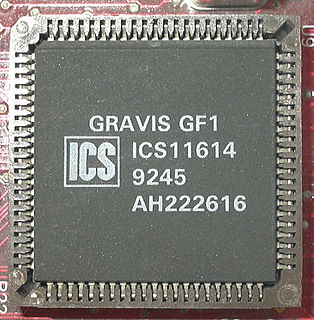 W
WGravis UltraSound or GUS is a sound card for the IBM PC compatible system platform, made by Canada-based Advanced Gravis Computer Technology Ltd. It was very popular in the demo scene during the 1990s.
 W
WThe HardSID is a family of sound cards, produced by a Hungarian company Hard Software and originally conceived by Téli Sándor.
 W
WA headset combines a headphone with microphone. Headsets are made with either a single-earpiece (mono) or a double-earpiece. Headsets provide the equivalent functionality of a telephone handset but with handsfree operation. They have many uses including in call centers and other telephone-intensive jobs and for anybody wishing to have both hands free during a telephone conversation.
 W
WHercules was a manufacturer of computer peripherals for PC and Mac.
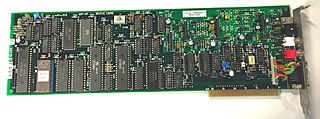 W
WThe IBM Music Feature Card and sometimes abbreviated as the IBM MFC, or just IMFC: is a professional-level sound card for the PC, and used the 8-bit ISA bus. The card made use of the Yamaha YM2164 chip which produces sound and music via FM synthesis.
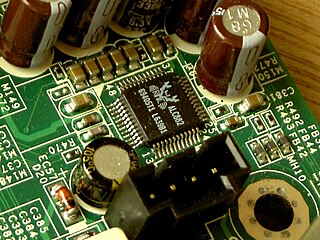 W
WIntel High Definition Audio (IHDA) is a specification for the audio sub-system of personal computers. It was released by Intel in 2004 as successor to its AC'97 PC audio standard.
 W
WThe Korg OASYS PCI is a DSP-based PCI-card for PC and Mac released in 1999. It offers many synthesizer engines from sampling and substractive to FM and physical modelling. Because of its high market price and low polyphony production was stopped in 2001. About 2000 cards were produced.
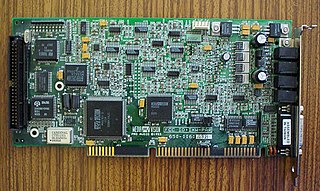 W
WThe Media Vision Pro AudioSpectrum family of personal computer sound cards included the original 8-bit Pro AudioSpectrum (1991), the 8-bit Pro AudioSpectrum Plus, 16-bit Pro AudioSpectrum 16, Pro AudioSpectrum 16 Basic and 16-bit Pro Audio Studio. All PAS cards with the exception of Pro AudioSpectrum 16 Basic could connect to CD-ROM drives—variants having SCSI or various proprietary interfaces—and many were sold in multimedia kits with compatible CD-ROM drives.
 W
WThe Mockingboard is a sound card for the Apple II family of microcomputers built by Sweet Micro Systems, which improve on the Apple II's limited sound capabilities.
 W
WOnkyo Corporation is a Japanese consumer electronics manufacturer, specializing in premium home cinema and audio equipment, including AV receivers, surround sound speakers and portable devices. The word Onkyo translates as "sound resonance". On (音) is from Chinese pronunciation, with traditional Japanese pronunciation as Oto, meaning "the sound". Kyo (響) is also from Chinese pronunciation, pronounced as Hibiki (noun) or Hibiku (verb) in traditional Japanese, meaning "resound, sound, or echo". The company started under the name of Osaka Denki Onkyo K.K in 1946. The current Onkyo Corporation umbrella includes the Integra and Integra Research divisions as well as the main Onkyo brand.
 W
WPhasor is a stereo music, sound and speech synthesizer created by Applied Engineering for the Apple II family of computers. Consisting of a sound card and a set of related software, the Phasor system was designed to be compatible with most software written for other contemporary Apple II cards, including the Sweet Micro Systems Mockingboard, ALF's Apple Music Synthesizer, Echo+ and Applied Engineering's earlier card Super Music Synthesizer.
 W
WThe Philips NMS-1205 was a MSX AUDIO cartridge using Yamaha Y8950 chip . NMS-1205 was only sold in Europe for MSX Personal Computer.
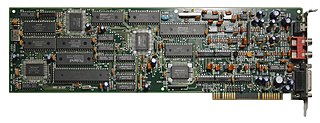 W
WThe Roland LAPC-I is a sound card for IBM PC compatible computers produced by Roland Corporation. It basically consists of a MT-32-compatible Roland CM-32L and a MPU-401 unit, integrated onto a single full-length 8-bit ISA card. In addition to normal Roland dealers aimed at musicians, it was distributed in the United States by Sierra On-Line in 1989 for use with the company's games. The MSRP of the card was around US$425.
 W
WRoland/Edirol Sound Canvas lineup is a series of General MIDI (GM) based pulse-code modulation (PCM) sound modules and sound cards, primarily intended for computer music usage, created by Japanese manufacturer Roland Corporation. Some models include a serial or USB connection, to a personal computer.
 W
WSound Blaster is a family of sound cards designed by Singaporean technology company Creative Technology. Sound Blaster sound cards were the de facto standard for consumer audio on the IBM PC compatible system platform, until the widespread transition to Microsoft Windows 95, which standardized the programming interface at application level, and the evolution in PC design led to onboard audio electronics, which commoditized PC audio functionality. By 1995, Sound Blaster cards had sold over 15 million units worldwide and accounted for seven out of ten sound card sales.
 W
WThe Sound Blaster 16 is a series of sound cards by Creative Technology. They are add-on boards for PCs with an ISA or PCI slot.
 W
WSound Blaster Audigy is a product line of sound cards from Creative Technology. The flagship model of the Audigy family used the EMU10K2 audio DSP, an improved version of the SB-Live's EMU10K1, while the value/SE editions were built with a less-expensive audio controller.
 W
WThe Sound Blaster AWE32 is an ISA sound card from Creative Technology. It is an expansion board for PCs and is part of the Sound Blaster family of products. The Sound Blaster AWE32, introduced in March 1994, was a near full-length ISA sound card, measuring 14 inches (356 mm) in length, due to the number of features included.
 W
WSound Blaster X-Fi is a lineup of sound cards in Creative Technology's Sound Blaster series.
 W
WA sound card is an internal expansion card that provides input and output of audio signals to and from a computer under control of computer programs. The term sound card is also applied to external audio interfaces used for professional audio applications.
 W
WSoundStorm is a brand by Nvidia regarding to a SIP block integrating 5.1 surround sound technology found on the die of their nForce and nForce2 chipsets for x86 CPUs. It is also the name of a certification to be obtained by Nvidia when complying with their specifications.
 W
WThe Thunder Board was an 8-bit mono personal computer integrated circuit sound card from Media Vision, that had Sound Blaster compatibility at a reduced price. It was widely advertised as “proudly made in the USA”; possibly a reference to the Sound Blaster, manufactured by the competing Singapore-based Creative Technologies. Emulates SB 1.0 and 1.5
 W
WThe Turtle Beach Corporation is a global gaming accessory manufacturer based in San Diego, California. It produces gaming headsets for Xbox One, PlayStation 4, PC, Nintendo Switch, and mobile devices. The company has roots dating back to the 1970s where it developed sound cards, MIDI synthesizers, and various audio software packages and network audio devices.
 W
WWindows Sound System (WSS) is a sound card specification developed by Microsoft released at the end of 1992 for Windows 3.1. WSS featured support for up to 16-bit, 48 kHz digital sampling, beyond the capabilities of the popular contemporary Sound Blaster Pro, although it was less frequently supported than Sound Blaster and Gravis sound cards, as well as Roland sound cards, daughterboards, and sound modules. In addition, the WSS featured RCA analog audio outputs, an uncommon feature among sound cards of this era; other connections were a microphone input, a stereo line input and a stereo headphone output.